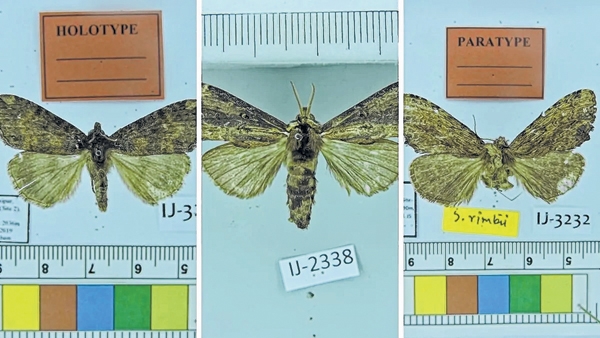Three moth species new to science found in Shirui Hills
|

Guwahati, Oct 29
Three moth species new to science have been reported from Manipur this time.
Three moth species new to science – Cleapa ukhrulensis, Spatalina rimbiensis and Hexafrenum tangkhula – have been discovered in Manipur by Jatishwor Singh Irungbam, a researcher at the Sphingidae Museum who also teaches at the University of South Bohemia, the Czech Republic.
Irungbam was assisted by Dr. Alexander Schintl-meister from Germany and Dr. Zdenek Faltynek Fric from the Czech Republic.
All three moth species were found from Shirui Hills in Manipur.
The study, published in the Zootaxa journal, discusses the systematic accounts of 66 species of the family Notodontidae recorded from Manipur. The study also reports on seventeen moth species of Notodontidae for the first time from India.
These moths belong to the Notodontidae family, which consists of mostly moderate to large-sized species with naturally cryptic but aesthetically attractive wing patterns. Their wings are usually long and relatively narrow like their abdomen.
The wing scaling is often coarse and the pattern is never very sharply defined. The body and legs are usually covered densely with long hair, giving the whole insect a rather bushy appearance.
Manipur, which is bordered by Nagaland to the north, Mizoram to the south, Assam to the west, and Myanmar to the east, is part of the Indo-Burma bio-diversity hotspot.
While Cleapa ukhrulensis and Hexafrenum tangkhula have been discovered from Shirui Hill in Ukhrul district, Spatalina rimbiensis has been found in Shirui Hill, Rimbi of Sikkim, and different localities of Nepal.
Hexafrenum tangkhula name is derived from “Tangkhul tribe” of the Naga community in Manipur, who play an important role in the conser- vation and protection of biodiversity in Shirui Hill, Manipur, and other two species were named on the localities where they were discovered.
Shirui Hill has a cold climate with temperatures between 3°C and 33°C. Most of the year, the upper ridges of Shirui Hill are covered with clouds but they receive rain from May till the beginning of October.
In the region, the average annual rainfall is about 1763.7 millimeters. There are a variety of rhododendron species that dominate the vegetation in the area.
Despite the relatively sparse population, the forest area is heavily disturbed by anthropogenic activities, such as seasonal cultivation, illegal tree felling, forest burning, and domesticated animal grazing, the study says.
“Many new species have been described from NE India over the past few years, suggesting that this region still has plenty of interesting species to discover. The State of Manipur still hasn’t been fully explored, and has the second largest and most pristine forests out of all the NE Indian states after Arunachal Pradesh,” the study says.
Researchers associated with the study say the new records indicate that the State is yet to be fully explored.
“Since the majority of the Notodontid moths are associated with hardwood trees, we have no knowledge about their larval biology, ecology, or host plant choice,” they said.
“For this reason, long-term monitoring of these moth groups has become necessary in order to fill in the gaps in our knowledge of their biology,” they said. EastMojo

